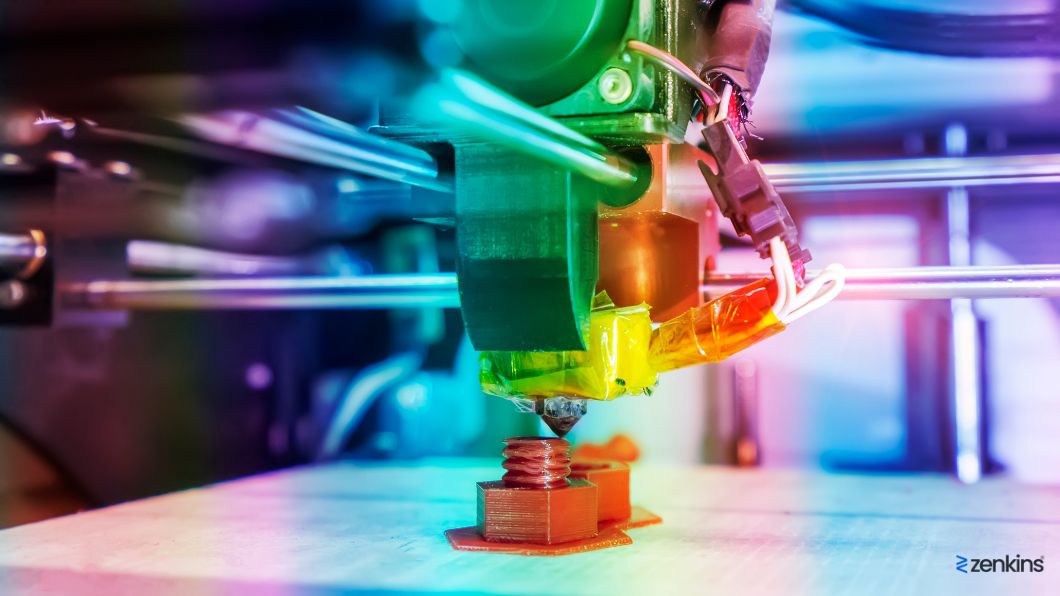Printing the Future: Custom Software for Seamless 3D Printing Integration
Table of Contents
Introduction
In recent years, 3D printing technology has emerged as a revolutionary force in manufacturing, offering unprecedented flexibility, customization, and efficiency. However, to fully harness the potential of 3D printing, businesses need more than just cutting-edge hardware – they require intelligent software solutions that seamlessly integrate with their existing workflows. In this blog, we’ll explore the transformative power of custom software for 3D printing integration, delving into its benefits, challenges, and real-world applications.
The Evolution of 3D Printing Technology
Before diving into the realm of custom software, it’s essential to understand the evolution of 3D printing technology. Initially developed for rapid prototyping, 3D printing has evolved into a versatile manufacturing tool capable of producing end-use parts across a wide range of industries. From aerospace and automotive to healthcare and consumer goods, 3D printing is revolutionizing traditional manufacturing processes by enabling on-demand production, design iteration, and geometric complexity that were previously unattainable.
The Role of Custom Software in 3D Printing
While the hardware aspect of 3D printing – such as printers, materials, and post-processing equipment – is crucial, it’s the software that acts as the brain behind the operation. Custom software solutions tailored specifically for 3D printing integration play a pivotal role in optimizing workflows, enhancing efficiency, and unlocking the full potential of additive manufacturing technologies. These software platforms offer a wide range of functionalities, including CAD modeling, slicing, nesting, scheduling, quality control, and real-time monitoring, all seamlessly integrated into a cohesive ecosystem.
Challenges in 3D Printing Integration
While the benefits of 3D printing are clear, integrating this technology into existing manufacturing workflows poses several challenges:
File Preparation
Preparing 3D models for printing involves various steps, including slicing, support generation, and optimization. Without the right software tools, this process can be time-consuming and error-prone.
Workflow Integration
3D printing must seamlessly integrate with existing manufacturing processes, including design, engineering, and quality control. Incompatibility between software systems can lead to inefficiencies and bottlenecks.
Quality Control
Ensuring the quality and consistency of 3D-printed parts requires robust quality control measures. Without adequate software solutions for process monitoring and inspection, manufacturers risk producing defective parts.
Scalability
As 3D printing adoption grows and production volumes increase, manufacturers need scalable software solutions that can support large-scale production and automation.
The Promise of 3D Printing in Manufacturing
Before delving into the importance of custom software, it’s essential to understand why 3D printing holds such promise in manufacturing:
Design Freedom
3D printing enables the creation of complex geometries and intricate designs that are difficult or impossible to achieve with traditional manufacturing methods. This design freedom allows for the optimization of part performance, lightweighting, and customization.
Rapid Prototyping
3D printing accelerates the product development cycle by enabling rapid prototyping and iteration. Design changes can be implemented quickly and cost-effectively, reducing time-to-market and facilitating innovation.
On-Demand Manufacturing
With 3D printing, manufacturers can produce parts on-demand, eliminating the need for large inventories and reducing lead times. This just-in-time production model enables greater flexibility, reduces waste, and lowers inventory costs.
Complexity without Complexity
Unlike traditional subtractive manufacturing processes, which require complex setups and tooling, 3D printing simplifies production by directly translating digital designs into physical objects. This eliminates the need for costly tooling and reduces setup times.
Benefits of Custom Software for 3D Printing Integration
Streamlined Workflows
Custom software streamlines the entire 3D printing workflow, from design to production, by automating repetitive tasks, optimizing print parameters, and minimizing manual intervention. This results in faster turnaround times, reduced labor costs, and improved overall efficiency.
Enhanced Design Flexibility
With custom software, designers have greater freedom to explore complex geometries, lattice structures, and lightweight designs that maximize material utilization and performance. Advanced CAD tools integrated into the software enable designers to translate their creative vision into tangible, manufacturable parts with ease.
Improved Quality Control
Custom software incorporates robust quality control mechanisms, such as automated inspection algorithms and real-time monitoring systems, to ensure the integrity and consistency of printed parts. By detecting defects early in the process, manufacturers can mitigate risks and maintain high-quality standards throughout production.
Cost Savings
By optimizing material usage, minimizing waste, and reducing downtime, custom software helps manufacturers achieve significant cost savings over time. Additionally, the ability to simulate and iterate designs digitally before physical production reduces prototyping costs and accelerates time-to-market for new products.
Scalability and Adaptability
Custom software solutions are designed to scale seamlessly with the growing needs of businesses, allowing them to adapt to changing market dynamics and technological advancements. Whether expanding production capacity or integrating new 3D printing technologies, businesses can rely on custom software to support their growth trajectory.
The Rise of the Machines: How AI-powered Defect Detection Enhances Manufacturing Quality
Challenges and Considerations
While the benefits of custom software for 3D printing integration are clear, businesses must also navigate certain challenges and considerations:
Technical Expertise
Developing custom software requires specialized knowledge of 3D printing technologies, CAD software, data analytics, and software development frameworks. Collaborating with experienced software developers or partnering with third-party vendors can help businesses overcome technical hurdles.
Integration Complexity
Integrating custom software with existing IT infrastructure, such as ERP systems, MES platforms, and IoT devices, can be complex and time-consuming. Careful planning, interoperability testing, and iterative development are essential to ensure seamless integration and data exchange between systems.
Data Security and Intellectual Property
Protecting sensitive data, proprietary designs, and intellectual property rights is paramount in the 3D printing ecosystem. Robust cybersecurity measures, data encryption, access controls, and digital rights management (DRM) mechanisms must be implemented to safeguard valuable assets from cyber threats and unauthorized access.
Regulatory Compliance
Compliance with industry regulations, quality standards, and safety requirements is critical for businesses operating in regulated sectors such as aerospace, healthcare, and automotive. Custom software should facilitate compliance with relevant standards, certifications, and regulatory frameworks to ensure legal compliance and market acceptance.
Real-World Applications
Aerospace
Custom software enables aerospace manufacturers to optimize part designs for lightweighting, reduce material waste through nesting algorithms, and perform virtual testing and simulation for structural integrity and performance validation.
Healthcare
In the healthcare sector, custom software facilitates the design and production of patient-specific medical implants, prosthetics, and anatomical models for surgical planning and training, improving patient outcomes and healthcare delivery.
Automotive
Automotive companies leverage custom software for 3D printing integration to prototype new vehicle components, optimize vehicle performance, and customize interior features, such as dashboard panels and trim pieces.
Consumer Goods
Custom software empowers consumer goods manufacturers to create customized products, personalized accessories, and limited-edition merchandise tailored to individual customer preferences, driving brand loyalty and customer engagement.
Case Study: Maximizing Efficiency with Custom 3D Printing Software
Consider a aerospace manufacturer seeking to leverage 3D printing for the production of lightweight, complex components. By partnering with a custom software development company, the manufacturer implemented a custom 3D printing software solution:
Automated File Preparation: The custom software automated the file preparation process, optimizing part orientation, support structures, and print settings for each component. This streamlined the workflow and reduced manual intervention, enabling engineers to focus on design optimization.
Workflow Integration: The custom software integrated seamlessly with existing CAD/CAM systems and production workflows. Engineers could design parts in CAD software, export files directly to the 3D printing software, and monitor print progress in real-time, ensuring alignment and continuity throughout the design and production process.
Advanced Quality Control: The custom software incorporated advanced quality control features, including in-process monitoring and real-time inspection. Sensors embedded in the 3D printers captured data on temperature, humidity, and print quality, enabling operators to detect deviations and implement corrective actions proactively.
Scalable Production Management: The custom software provided scalable production management tools that supported large-scale 3D printing operations. Engineers could schedule print jobs, allocate resources, and monitor production analytics from a centralized dashboard, optimizing throughput and maximizing equipment utilization.
Conclusion
Custom software for 3D printing integration represents a paradigm shift in manufacturing, empowering businesses to unlock new levels of innovation, efficiency, and competitiveness. By embracing custom software solutions tailored to their specific needs, businesses can streamline production workflows, enhance design flexibility, improve quality control, and achieve cost savings while staying ahead of the curve in today’s rapidly evolving marketplace. As the manufacturing landscape continues to evolve, custom software will play a central role in shaping the future of additive manufacturing and driving the next wave of industrial transformation.
Frequently Asked Questions
How does custom software improve the efficiency of 3D printing workflows?
Custom software streamlines 3D printing workflows by automating file preparation processes such as slicing, support generation, and part orientation. This automation reduces manual intervention, minimizes errors, and optimizes print settings for quality, speed, and material efficiency. Additionally, custom software seamlessly integrates 3D printing into existing manufacturing workflows, connecting design, engineering, and production processes to ensure alignment and continuity throughout the product lifecycle.
What role does custom software play in quality control for 3D-printed parts?
Custom software plays a crucial role in quality control for 3D-printed parts by incorporating advanced features such as in-process monitoring, real-time inspection, and automated defect detection. Sensors embedded in 3D printers capture data on temperature, humidity, and print quality, allowing operators to detect deviations and implement corrective actions proactively. Additionally, custom software analyzes sensor data and provides feedback on part quality, enabling manufacturers to assess part quality and ensure compliance with specifications in real-time.
How does custom software support scalability in 3D printing operations?
Custom software provides scalable production management tools that support large-scale 3D printing operations. Engineers can schedule print jobs, allocate resources, and monitor production analytics from a centralized dashboard, optimizing throughput and maximizing equipment utilization. Additionally, custom software enables efficient batch processing and job queuing, ensuring smooth and efficient production at scale. By providing scalable solutions that align with the specific needs and processes of each manufacturing operation, custom software supports the growth and expansion of 3D printing operations.
Can custom software integrate with existing CAD/CAM systems and production workflows?
Yes, custom software can integrate seamlessly with existing CAD/CAM systems and production workflows. Engineers can design parts in CAD software, export files directly to the 3D printing software, and monitor print progress in real-time. Custom software facilitates data exchange and collaboration across departments, ensuring alignment and continuity throughout the design and production process. By providing interoperable solutions that connect design, engineering, and production processes, custom software enables manufacturers to leverage the capabilities of 3D printing within their existing workflows and operations.




